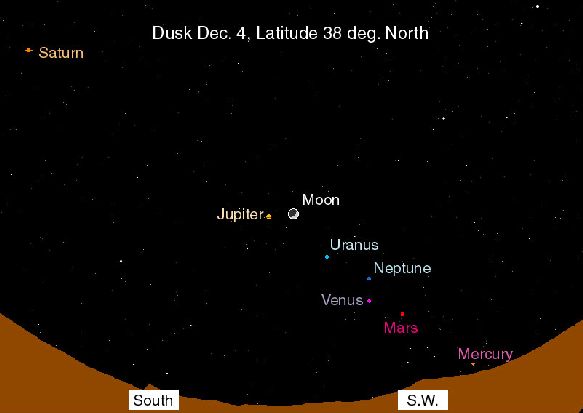Credit & Copyright: T. Bridgman (
GSFC and
Greenbelt Astronomy Club),
Carina Software
Explanation:
Look up tonight.
Just after sunset, the crescent moon and
all five "naked-eye" planets
(Mercury,
Venus,
Mars,
Jupiter,
and Saturn)
will be visible (depending on your latitude), lying near
our solar system's ecliptic plane.
Venus and Jupiter will shine brilliantly as the brightest "stars"
in the sky, but Mercury will be near the horizon and hard to see.
A pair of binoculars will also reveal Uranus and Neptune and
observers with a telescope and a good site may even be able
to glimpse faint Pluto just above the
Western horizon in the fading twilight (not shown on the chart above).
Enjoy this lovely spectacle
any clear night through about December 8.
A similar gathering is expected in May 2000
but the planets will be hidden from view by the solar glare.
A night sky as full of planets as this one will occur
again though ... in about 100 years.
1999 2000 2001 2002 2003 2004 2005 2006 2007 2008 2009 2010 2011 2012 2013 2014 2015 2016 2017 2018 2019 2020 2021 2022 2023 2024 2025 |
Yanvar' Fevral' Mart Aprel' Mai Iyun' Iyul' Avgust Sentyabr' Oktyabr' Noyabr' Dekabr' |
NASA Web Site Statements, Warnings, and Disclaimers
NASA Official: Jay Norris. Specific rights apply.
A service of: LHEA at NASA / GSFC
& Michigan Tech. U.
|
Publikacii s klyuchevymi slovami:
planet - ecliptic - Solar System - solnechnaya sistema - Ekliptika - planety
Publikacii so slovami: planet - ecliptic - Solar System - solnechnaya sistema - Ekliptika - planety | |
Sm. takzhe:
Vse publikacii na tu zhe temu >> | |
